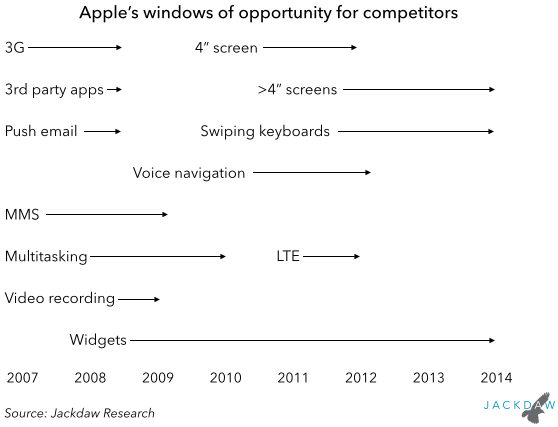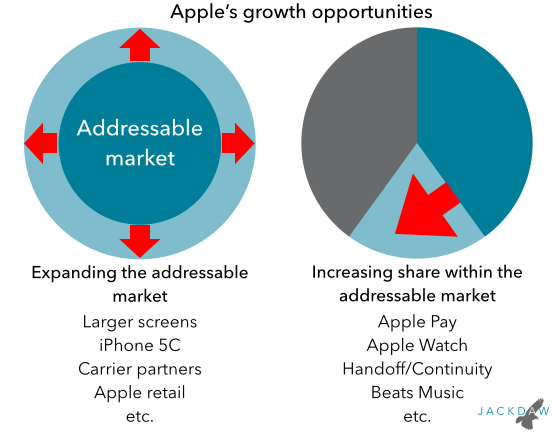This is the first of what will likely be several pieces from me over the course of this week on Apple’s big announcements, both here and in my weekly Techpinions column. This one focuses on the iPhone specifically.
Apple has always provided windows of opportunity for competitors
In the in-depth Apple profile I wrote for clients a couple of months ago, I said the following:
Apple competes very effectively in the market segments it targets, but deliberately limits the segments of the markets it competes in.
As a corollary to that, one of my first recommendations to Apple’s competitors was:
Play where Apple isn’t. The easiest approach to take is to play where Apple chooses not to. Early in this report, we discuss Apple’s focused approach and the ways in which it limits its own addressable market through its focus on premium devices, a small number of devices, and a relatively controlled approach to customization. Competitors should play up their differences and focus on those markets where Apple doesn’t play, or doesn’t play effectively. Very few companies can go up against Apple in its target markets and win.
What’s been fascinating about Apple’s history with the iPhone is the ways in which it has deliberately held back features or functionality in either hardware or software which competitors offer. In the process, it’s provided a series of windows of opportunity for competitors to differentiate on that basis, and to hammer Apple for it in their advertising. The chart below shows a number of these features and the windows of opportunity Apple has allowed competitors to offer them without competition. In each case, the starting point is when major competitors began to offer the feature, and the ending point is when Apple began offering it, either in iPhone hardware or in iOS. (To be sure, some of these were far more useful and meaningful differentiators than others). In some cases, the window has been very small, lasting just a year or so. Such was the case with the initial iPhone’s lack of 3G, push email and third party apps. But other windows have lasted much longer, such as the absence of widgets. But in all these cases, Apple has been content to allow competitors free rein in these areas while it either didn’t consider the feature important or wanted to wait until it could get it right.
In some cases, the window has been very small, lasting just a year or so. Such was the case with the initial iPhone’s lack of 3G, push email and third party apps. But other windows have lasted much longer, such as the absence of widgets. But in all these cases, Apple has been content to allow competitors free rein in these areas while it either didn’t consider the feature important or wanted to wait until it could get it right.
Apple just closed an important window
Notably, one of the longest-running and most significant windows for competitors has been larger screen sizes, beginning with 4-inch screens in 2010 with the launch of the Samsung Galaxy S and expanding beyond that size the year after with a variety of larger models. With the launch of the iPhone 6 and 6 Plus, however, Apple has now closed that window. In reality, this may be seen as two different windows, because there are really two larger screen categories in which Apple hasn’t competed but now does: mainstream smartphones at roughly 4.5-5.2″, and “phablets” at over 5.2″ 1 Apple has closed both windows in one fell swoop.
The impact will be that competitors which have differentiated on screen size will now need to find something else to compete on. During all these windows, wise competitors will have found ways to prepare for Apple’s inevitable entry by providing additional differentiators above and beyond the basic ones. Samsung’s focus on the stylus with the Galaxy Note series is a good example of this – were the Note simply a very large phone, it would now have become relatively undifferentiated from the iPhone Plus, but the stylus still sets it apart following yesterday’s announcements. Exactly how much people care about that feature versus the size itself is a critical question which the next few months will answer. I’m predicting a significant shift in market share from Android in particular to iOS among larger screen sizes in the coming months, both in the mainstream large phone category and the phablet category.
Competing where Apple isn’t just got harder
In a much smaller way, Apple has also closed some other, less significant windows with the iPhone 6 and 6 Plus release and with iOS 8. NFC for payments, widgets in Notification Center, and third party keyboards (including swiping keyboards) all close gaps with Android and to an extent Windows Phone. Though not as significant as the larger screens, they also help eliminate options for competitors to play where Apple isn’t. Apple’s windows of opportunity have allowed competitors to differentiate on the basis of checkboxes as well as feature performance, but as the list of checkboxes Apple doesn’t check but competitors do shrinks, other vendors will have to focus more on competing on feature performance rather than merely feature presence.
This is particularly tough because essentially all other competitors are heavily reliant on Google and Microsoft to provide much of the functionality in their handsets, with only a small amount provided through hardware. In arguably one of the most important potential hardware differentiators – the camera – competitors except for Nokia (now Microsoft) fall well short of Apple’s performance. On essentially all other points, competitors’ hardware remains inferior in performance, build quality and design. But they’re reliant on their OS licensing partners for the rest, and have both very little control over the process of OS rollouts and very little differentiation against their competitors using the same OS. This challenge will only be reinforced as Apple closes more of these windows.
One big window remains: price
The one significant remaining window for competitors to play where Apple isn’t is price. Though Apple has steadily expanded its range of price points by keeping older devices in market, it still doesn’t compete with current-generation devices in the mid- or low-end, and this allows competitors one major window still. However, there are two problems with this: margins tend to be low at this end of the market, and Apple’s older devices serve the need fairly well for much of the mid market and an increasing proportion of emerging market users. In addition, there’s also the possibility that Apple may eventually close this window more fully, which Benedict Evans has done an excellent job thinking through. I agree with him that the financial incentives are unclear, though there may be other benefits. If that window ever does close, the iPhone’s addressable market will expand even more significantly than it did with the iPhone 6, and competitors will find it even harder to compete.
Apple’s market expansion opportunities are shrinking too
If you think about how Apple can grow its iPhone business, there are essentially two core strategies, as shown in the diagram below: expanding the addressable market, and increasing share within the addressable market:

Though Apple’s progressive closing of the windows of opportunity for competitors is bad for them, it also means that many of the obvious opportunities for Apple to increase the addressable market for the iPhone are shrinking. Aside from price, there aren’t any obvious new levers for Apple to pull to expand its target audience. Distribution is now almost maxed out, with the vast majority of the world’s countries and operators now offering the iPhone, and growth in the premium end of the smartphone market is slowing too. As such, Apple’s opportunities for growth in its addressable market beyond this current round are shrinking.
As I’ve said before, this will lead to two things: a variety of smaller moves designed to provide incremental expansions in the markets Apple is able to address, with the IBM deal being a great example. But the other key initiative is going to be adding value to the iPhone ecosystem so as to increase share within the addressable market. So far, the ecosystem that exists around the iPhone has had two parts: iTunes, iCloud and other Apple software on the one hand, and third party accessories and devices on the other. Apple is now evolving both of these:
- first, by making the iPhone, and not iCloud/iTunes or the Mac, the center of the Apple universe, and developing features and concepts such as Handoff and Continuity which allow other Apple devices to work better in conjunction with the iPhone
- second, by developing a range of first-party accessories which will work uniquely well with the iPhone, starting with the Beats acquisition and continuing with the announcement of the Apple Watch.
As Apple does so, it will increase the attractiveness of the iPhone not just as a device in its own right but as the center of the Apple ecosystem, a unique one which no competitor can match at the scale and scope Apple can achieve. Google’s ecosystem is incredibly broad in software, but relies on loosely coupled third party devices for hardware. Microsoft now owns tablet and smartphone hardware as well as gaming consoles, but has such small market share in two of these three categories as to be almost meaningless. Even as Apple closes windows for competitors then, and begins to run out of additional windows to close, it’s opening a whole new front in its competitive efforts, which should see it continue to expand its share in its addressable market even as opportunities to expand that addressable market start to disappear.
Notes:
- Reasonable people can argue about where the dividing line is, but that isn’t worth debating here. ↩